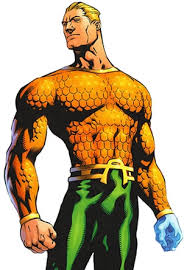Aquaman
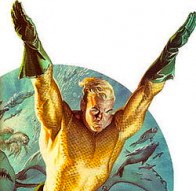
Aquaman: The Rampaging Reptile-Men
1960’s Aquaman cartoon. Aquaman and Aqualad!
 Art by Alex Ross.
Art by Alex Ross.
Aquaman is a superhero who stars in many comic book titles by DC Comics. Created by Paul Norris and Mort Weisinger, the character debuted in More Fun Comics #73 (November 1941). Initially a backup feature in DC’s anthology titles, Aquaman later starred in several volumes of a solo title. During the late 1950’s and 1960s superhero-revival period known as the Silver Age, he was a founding member of the Justice League of America. In the 1990s Modern Age, Aquaman’s character became more serious than in most previous interpretations, with storylines depicting the weight of his role as king of Atlantis. Later accounts reconciled both facets of the character, casting Aquaman as serious and broody, saddled with an ill reputation and struggling to find a true role and purpose beyond his public side as a deposed king and a fallen hero.
Fictional character biography – Golden Age of Comics
Aquaman’s first origin story was presented in flashback from his debut, narrated by the character himself:
The story must start with my father, a famous undersea explorer — if I spoke his name, you would recognize it. My mother died when I was a baby, and he turned to his work of solving the ocean’s secrets. His greatest discovery was an ancient city, in the depths where no other diver had ever penetrated. My father believed it was the lost kingdom of Atlantis. He made himself a water-tight home in one of the palaces and lived there, studying the records and devices of the race’s marvelous wisdom. From the books and records, he learned ways of teaching me to live under the ocean, drawing oxygen from the water and using all the power of the sea to make me wonderfully strong and swift. By training and a hundred scientific secrets, I became what you see — a human being who lives and thrives under the water.
In his early Golden Age appearances, Aquaman could breathe underwater and control fish and other underwater life for up to a minute. Initially, he was depicted as speaking to sea creatures “in their own language” rather than telepathically, and only when they were close enough to hear him (Within a 20 yard radius). Aquaman’s adventures took place all across the world, and his base was “a wrecked fishing boat kept underwater,” in which he lived.
During his wartime adventures, most of Aquaman’s foes were Nazi U-boat commanders and various Axis villains. The rest of his adventures in the 1940’s and 1950’s had him dealing with various sea-based criminals, including modern-day pirates such as his longtime archenemy Black Jack, as well as various threats to aquatic life, shipping lanes, and sailors.
Aquaman’s last appearance in More Fun Comics was in issue #107, before being moved along with Superboy and Green Arrow to Adventure Comics starting with issue #103 in 1946.
Aquaman’s adventures continued to be published in Adventure Comics through the 1940s and 1950s, as one of the few superheroes to last through the 1950’s in continuous publication. Starting in the late 1950s, new elements to Aquaman’s backstory were introduced, with various new supporting characters added and several adjustments made to the character, his origins, his powers, and persona. The first of these elements was the story “Aquaman’s Undersea Partner” inAdventure Comics #229 (October 1956), where his octopus sidekick, Topo, was first introduced. This and subsequent elements were later (after the establishment of DC’s multiverse in the 1960’s) attributed to the Aquaman of Earth-One.
In Adventure Comics #260 (May 1959) and subsequent Silver Age comics, it was revealed that Aquaman was Arthur Curry, the son of Tom Curry, a lighthouse keeper, and Atlanna, a water-breathing outcast from the lost, underwater city of Atlantis. Due to his heritage, Aquaman discovered as a youth that he possessed various superhuman abilities, including the powers of surviving underwater, communication with sea life, and tremendous swimming prowess. Eventually, Arthur decided to use his talents to become the defender of the Earth’s oceans. It was later revealed that he had, in his youth, adventured as Aquaboy and met Superboy (Earth’s only other publicly active superpowered hero at the time) on one occasion. When Arthur grew up, he called himself “Aquaman”.
It was later revealed that after Atlanna’s death, Tom Curry met and married an ordinary human woman and had a son named Orm Curry, Aquaman’s half-brother. Orm grew up as a troubled youth in the shadow of his brother, who constantly bailed him out of trouble with the law. He grew to hate Aquaman not only for the powers that he could never possess but also because he believed that their father would always favor Aquaman. Orm disappeared after becoming an amnesiac and would resurface years later as Aquaman’s archnemesis, Ocean Master.
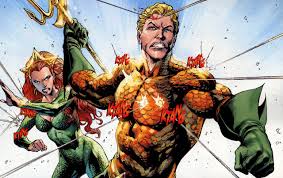 Aquaman’s ability to talk with fish eventually expanded to full-fledged telepathic communication with sea creatures even from great distances and he was also retroactively developed a specific weakness akin to Superman‘s vulnerability to kryptonite or Green Lantern‘s vulnerability to the color yellow: Aquaman had to come into contact with water at least once per hour, or he would die (prior to this story Aquaman could exist both in and out of water indefinitely.)
Aquaman’s ability to talk with fish eventually expanded to full-fledged telepathic communication with sea creatures even from great distances and he was also retroactively developed a specific weakness akin to Superman‘s vulnerability to kryptonite or Green Lantern‘s vulnerability to the color yellow: Aquaman had to come into contact with water at least once per hour, or he would die (prior to this story Aquaman could exist both in and out of water indefinitely.)
Allies and foes
Aquaman was included in the Justice League of America comic book series, appearing with the team in their very first adventure, and was also a founding member of the team. Aquaman took part in most of the 1960s adventures of the superhero team.
Aquaman’s supporting cast and rogues gallery soon began to grow with the addition of Aqualad, an outcast, orphaned youth from an Atlantean colony whom Aquaman takes in and begins to mentor. Aquaman later discovered the submerged fictional city of New Venice, and which also became Aquaman’s base of operations for a time.
Aquaman was recognized as the son of Atlanna and was later voted to be the King after the death of the former regent, who had no heirs. By this time Aquaman had met Mera, a queen from a water-based dimension, and married her shortly after he had become king. They soon had a son, Arthur, Jr. (nicknamed “Aquababy”).
The 1960s series introduced other such archenemies as the Ocean Master (Aquaman’s amnesiac half-brother Orm), Black Manta, the Fisherman, the Scavenger, and the terrorist organization known as O.G.R.E.. Other recurring members of the Aquaman cast introduced in this series include the well-meaning but annoying Quisp (a water sprite); Dr. Vulko, a trustworthy Atlantean scientist who became Aquaman’s royal adviser and whom Aquaman eventually appoints to be king after leaving the throne himself; and Tula (known as “Aquagirl“), an Atlantean princess who was Aqualad’s primary love interest.
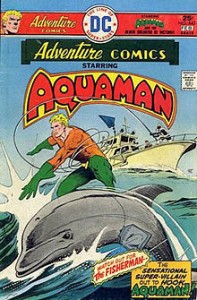 Aquaman in Adventure Comics #443. (Jan. 1976) Art by Jim Aparo.
Aquaman in Adventure Comics #443. (Jan. 1976) Art by Jim Aparo.
End of an Era
In the mid-1980’s, after his own feature’s demise, Aquaman was briefly made the leader of the Justice League of America. In a storyline told in Justice League of America #228-230, an invasion of Earth by a race of Martians occurred at a time when the core members were missing. Aquaman was thus forced to defend Earth with a League much-depleted in power and capability, and he took it upon himself to disband the Justice League altogether in Justice League of America Annual #2 (1984), thereafter reforming it with new bylaws requiring members to give full participation to the League’s cases. With the help of Martian Manhunter, Zatanna, and Elongated Man, veteran Justice League members willing to fully commit to the team, Aquaman recruited and trained four new and untried members, Gypsy, Vibe, Vixen, and Steel, also relocating the team’s headquarters to a reinforced bunker in Detroit, Michigan after the destruction of the JLA’s satellite headquarters during the invasion. Aquaman’s participation in this new version of the Justice League ended in #243 (Oct. 1985), when he resigned to work on his marriage with Mera.
Modern Age
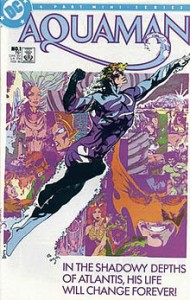 The deep-blue camouflage costume, from Aquaman vol. 2, #1 (Feb. 1986). Art by Craig Hamilton.
The deep-blue camouflage costume, from Aquaman vol. 2, #1 (Feb. 1986). Art by Craig Hamilton.
After the 1985 Crisis on Infinite Earths limited series, several short limited series were produced in the late 1980s and early 1990s — beginning with 1986’s four-issue Aquaman(Feb. – May 1986), written by Neal Pozner, featuring Aquaman in a new, largely deep-sea blue, costume. The series was well received and a follow up limited series was in the works, though it was eventually canceled due to creative problems. This series also expanded on several details of the Silver Age Aquaman’s origin as well as Aquaman’s relationship with his half-brother, Ocean Master, whose origin was retold in more complete detail. The series also added mystical elements to Aquaman’s mythology and reinvented Ocean Master as a sorcerer. Aquaman reappeared in his blue costume in the Aquaman Special #1 (1988).
In late 1988, the character appeared in the Invasion! crossover, guest starring with theDoom Patrol, again in the orange and green costume.
Retelling origins
In 1989, the Legend of Aquaman Special (officially titled as Aquaman Special #1 in the comic’s legal indicia, the second Special in back-to-back years) rewrote Aquaman’s mythos and origin, though keeping most of his Silver Age history intact. The special was by writer Robert Loren Fleming, with plots/breakdown art by Keith Giffen and full pencil art by artist Curt Swan.
The Modern Age Aquaman is born as Orin to Queen Atlanna and the mysterious wizard Atlan in the Atlantean city of Poseidonis. As a baby, he was abandoned on Mercy Reef (which is above sea level at low tide, causing exposure to air which would be fatal to Atlanteans) because of his blond hair, which was seen by the superstitious Atlanteans as a sign of a curse they called “the Mark of Kordax.” The only individual who spoke up on Orin’s behalf was Vulko, a scientist who had no patience for myth or superstition. While his pleas fell on deaf ears, Vulko would later become a close friend and advisor to the young Orin.
As a feral child who raised himself in the wilds of the ocean with only sea creatures to keep him company, Orin was found and taken in by a lighthouse keeper named Arthur Curry who named Orin “Arthur Curry” after himself. One day, Orin returned home and found that his adoptive father had disappeared, so he set off on his own. In his early teens, Orin ventured to the far north, where he met and fell in love with an Inupiat girl named Kako. He also first earned the hatred of Orm, the future Ocean Master who was later revealed to be Arthur’s half-brother by Atlan and an Inupiat woman (Time and Tide, no. 4). Orin was driven away before he could learn that Kako had become pregnant with his son, Koryak.
 Orin then returned to the seas mostly staying out of humanity’s sight, until he discovered Poseidonis. He was captured by the city’s then-dictatorial government and placed in a prison camp, where he met Vulko, also a prisoner of the state, who taught Orin the language and ways of the Atlanteans. While Orin was there, he realized that his mother was also being held captive, but after her death he broke out and fled. Eventually, he made his way to the surface world, where under the name of “Aquaman” he became one of several superheroes emerging into the public view at the time. Upon his return to Poseidonis, he was made the king, and sometime later he met and married Mera. The Modern Age Aquaman’s history is nearly identical to that of the Silver Age Aquaman from this point on.
Orin then returned to the seas mostly staying out of humanity’s sight, until he discovered Poseidonis. He was captured by the city’s then-dictatorial government and placed in a prison camp, where he met Vulko, also a prisoner of the state, who taught Orin the language and ways of the Atlanteans. While Orin was there, he realized that his mother was also being held captive, but after her death he broke out and fled. Eventually, he made his way to the surface world, where under the name of “Aquaman” he became one of several superheroes emerging into the public view at the time. Upon his return to Poseidonis, he was made the king, and sometime later he met and married Mera. The Modern Age Aquaman’s history is nearly identical to that of the Silver Age Aquaman from this point on.
As detailed in the five-issue Aquaman limited series (June – Oct. 1989) (by the same creative team of the 1989 special of Robert Loren Fleming, Keith Giffen, and Curt Swan), which continued a few of the themes from the Legend of Aquaman Special, Mera was eventually driven insane by grief over the death of Arthur, Jr., and was committed to an asylum in Poseidonis. Shortly afterwards, an alien force conquered Atlantis. Arthur was forced to save the city but was hampered by an escaped Mera who personally blamed Arthur for the death of their son. In a fit of rage, Mera left Aquaman’s dimension.
The publication of writer Peter David‘s The Atlantis Chronicles #1-7 (March – Sept. 1990), which told the story of Atlantis from antediluvian times to Aquaman’s birth, successfully revived interest in the character introduced the ancient Atlantean characters Orin (after whom Aquaman was named) and Atlan (who was revealed to be Aquaman’s father).
A new Aquaman ongoing series with creative team Shaun McLaughlin and Ken Hooper (#1-13) thereafter ran from December 1991 to December 1992, which portrayed Aquaman reluctantly deciding to remain in Poseidonis as its protector once again. For a time, he served as Atlantis’ representative to the United Nations but always found himself thrust back into the superhero role. Becoming more and more of a workaholic and solitary figure, Aquaman eventually returned to the oceans. He soon became tangled up in another attempt by Black Manta to destroy Atlantis by dragging it into a war with a surface nation.
Peter David returned to the character in another limited series, Aquaman: Time and Tide, a 1993/1994 four-issue series which further explained Aquaman’s origins as he finally learned all about the history of his people through the Atlantis Chronicles(presented as historical texts passed down and updated through the centuries). Aquaman learned that his birth name was Orin and that he and his enemy Ocean Master shared the same father, “an ancient Atlantean wizard” named Atlan. This revelation sent Orin into a bout of rage and depression, setting the stage for later confrontations between the two, as it was said in the Chronicles that “two brothers will also battle for control of Atlantis” (the Silver Age Aquaman had always known that the Ocean Master was his half-brother Orm, although Orm’s amnesia prevented him from remembering that fact for some time). This series is credited by Kevin Melrose of Comic Book Resources with helping the character reach the height of his modern-era popularity.
New direction
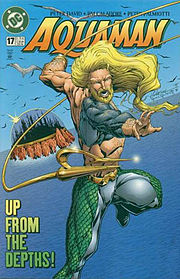 The 1990’s version of Aquaman, from Aquaman vol. 5, #17 (Feb. 1996). Art by Jim Calafiore.
The 1990’s version of Aquaman, from Aquaman vol. 5, #17 (Feb. 1996). Art by Jim Calafiore.
Aquaman received his own series again with the publication of the fifth Aquaman #1 (Aug. 1994), initially scripted by Peter David, following up on his 1993 Aquaman: Time and Tidelimited series. This new Aquaman series was the longest-running for the character, lasting until its 75th issue. David left the series after issue #46 (July 1998) after working on it for nearly four years.
David began by giving Aquaman an entirely new look, forsaking his former clean-cut appearance. Following his discoveries reading the Atlantis Chronicles during the Time and Tide series, Aquaman withdraws from the world for a time. Garth finds him weeks later, with his hair and beard grown long, brooding in his cave. Soon after (vol. 5, #2, Sept. 1994), Aquaman loses his left hand when the madman Charybdis steals his ability to communicate with sea life and sticks Arthur’s hand into a piranha-infested pool. This causes Aquaman to become somewhat unhinged, and he begins having prophetic dreams, and then, in need of a “symbol”, attaches a harpoon spearhead to his left arm in place of his missing hand. His classic orange shirt is shredded in a battle with Lobo (#4), and rather than replace it he goes shirtless for a while before donning a gladiatorial manica (#5). After the destruction of the harpoon (#8), Aquaman has it replaced with a cybernetic prosthetic from S.T.A.R. Labs (#9). This new harpoon has a retractable reel that he can fully control.
A major storyline, culminating in #25, concerns the Five Lost Cities of Atlantis. Facing an unearthly invading species linked to the origin of the Atlanteans, Aquaman has to search out and unite the lost cities. This storyline establishes him as a Warrior King, and he becomes a major political power, ruling largely undisputed over all the Atlantean cities. The remainder of Peter David’s run focused on Orin coming to terms with his genetic heritage and his role as a king. During this time he discovers the remnants of a sentient alien ship beneath Poseidonis, and is able to take control of it, returning Poseidonis to the surface and bringing Atlantis into greater contact with the outside world. The cultural changes this brings about, including increased tourism, as well as his conflicting duties as superhero and king, bring him into increasing tension with the political powers in his city.
 After a brief stint by Dan Abnett and Andy Lanning, David was replaced as writer by Erik Larsen with issue #50 (Dec. 1998) and again by Dan Jurgens in issue #63 (Jan. 2000); the series ended with #75 (Jan. 2001). During this time his wife Mera returns, now sane again, from the otherworldly dimension where she had been trapped, and Aquaman narrowly averts a coup d’état orchestrated by his son Koryak and his advisor Vulko. His second harpoon is also destroyed, this time in a battle with Noble, king of the Lurkers; he replaces it with a golden prosthetic hand developed by Atlantean scientists which can change shape at his command, thus retaining the powers of the harpoon but being more all-purpose. After a brief war with an island nation, Aquaman expands Atlantis’ surface influence by annexing the country to Atlantis.
After a brief stint by Dan Abnett and Andy Lanning, David was replaced as writer by Erik Larsen with issue #50 (Dec. 1998) and again by Dan Jurgens in issue #63 (Jan. 2000); the series ended with #75 (Jan. 2001). During this time his wife Mera returns, now sane again, from the otherworldly dimension where she had been trapped, and Aquaman narrowly averts a coup d’état orchestrated by his son Koryak and his advisor Vulko. His second harpoon is also destroyed, this time in a battle with Noble, king of the Lurkers; he replaces it with a golden prosthetic hand developed by Atlantean scientists which can change shape at his command, thus retaining the powers of the harpoon but being more all-purpose. After a brief war with an island nation, Aquaman expands Atlantis’ surface influence by annexing the country to Atlantis.
Hiatus between series
Aquaman had no regular series of his own from 2001–2003, but his plot went through several developments via his cameo appearances in several other titles.
Aquaman had rejoined the JLA when it reformed and remains an active, if sometimes reluctant member of that team until the Our Worlds at War event in 2001 (shortly after the cancellation of Aquaman vol. 5), during which Aquaman and the city of Poseidonis disappeared and were presumed to be destroyed during a confrontation between Aquaman and an Imperiex probe. In its place was simply a huge rift in the water of the ocean, with a vast spectral statue of Aquaman standing over it that the JLA installed as a holographic ‘beacon’ to both warn ships away from the trench and provide a signal for the Atlanteans to use if they were ever able to find their way back.
The Justice League eventually found that the city was still there, just magically shielded, but in ruins and apparently uninhabited. The Atlanteans were trapped in the ancient past, where Tempest had sent them as a last measure when it appeared that the city would be destroyed by the probe. There, however, they were enslaved by their own Atlantean ancestors, led by a powerful sorceress named Gamemnae, and Aquaman himself was transformed into living water and imprisoned in an ornamental pool. Over time, this civilization had collapsed until only Gamemnae herself, now immensely powerful, inhabited the ruins.
After a few months of their time — but fully fifteen years for the Atlanteans — the JLA free Aquaman in “The Obsidian Age” storyline in JLA. Although the original League were killed by Gamemnae, their souls were contained by the magician Manitou Raven to use in a spell to contain Gamemnae in Atlantis until the present day, when he was able to resurrect them. With the aid of Nightwing, Hawkgirl, Firestorm, Zatanna and Manitou Raven– the first four being members of the ‘reserve JLA’ that had been put together by an automatic program created by Batman that kicked in after the League vanished into the past, who had gone back in time with the aid of the Manitou Raven of their time-, Aquaman is freed from his prison in the pool, Firestorm linking the pool to the ocean and Zatanna enhancing his powers so that he can now control the entire ocean as a water wraith. With this power, Aquaman is able to sever Gamemnae’s connection to the city by sinking it under the sea again. While he fought Gamemnae, the League members returned the modern Atlanteans to the present where they could begin rebuilding the city, which in the present too was once again at the bottom of the sea.
Back to basics
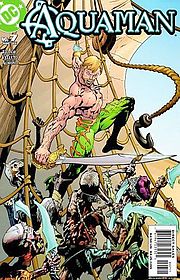 2003 series’ initial look by Yvel Guichet.
2003 series’ initial look by Yvel Guichet.
A sixth Aquaman series began shortly afterwards, initially written by Rick Veitch who sought to take Aquaman in a more mystical direction. Subsequent writers who contributed to the series include John Ostrander, Will Pfeifer, Tad Williams, and John Arcudi. This series ran 57 issues starting in December 2002 (cover dated February 2003); starting with #39 (April 2006), following the events of Infinite Crisis, it was renamed Aquaman: Sword of Atlantis.
Aquaman was blamed by his people for the initial decision to take them back in time, and sentenced to death. He escaped, and met the Lady of the Lake, who gave him a new prosthetic hand composed of mystical water with unusual properties. From there he gradually returned to his more traditional look—orange shirt, short hair, and beardless—but did not return to his city for several years.
Later, Aquaman went to San Diego after a massive earthquake plunged half the city into the Pacific Ocean. He discovered that many people had survived the catastrophe, somehow gaining the ability to breathe underwater, and he began helping them to rebuild the submerged portion of the city they now called “Sub Diego“. During this time, Aquaman picked up a new sidekick named Lorena, who eventually became the new Aquagirl: she was the only one of the Sub Diegans who retained the ability to breathe air as well as water.
 Aquaman’s exile turned out to have been orchestrated by a sorcerer class who had come to power using knowledge gained in the Obsidian Age; after they were overthrown the city made overtures for him to return as their king. He declined, but for a time, it appeared that Aquaman might reconcile with Mera, as he attempted to take her to the surface in order to save her from the Atlantean mages who had transformed her into an air-breather.
Aquaman’s exile turned out to have been orchestrated by a sorcerer class who had come to power using knowledge gained in the Obsidian Age; after they were overthrown the city made overtures for him to return as their king. He declined, but for a time, it appeared that Aquaman might reconcile with Mera, as he attempted to take her to the surface in order to save her from the Atlantean mages who had transformed her into an air-breather.
As a metatextual nod to the positive reception of the new series, a scene in Grant Morrison‘s Seven Soldiers event shows Aquaman winning the “Best Comeback” award at a popular superhero convention.
Shortly thereafter, during the Infinite Crisis event, Atlantis was destroyed by the Spectre, and many of its citizens were killed, including Aquaman’s son Koryak and his oldest friend (and father figure) Vulko. Aquaman led the survivors to Sub Diego in the hope that the two displaced peoples could help each other. When Black Manta attacked the sunken city, Aquaman defeated him and left him for dead, surrounded by carnivorous fish (it was later revealed that Manta survived, although it remains unclear whether Aquaman intended his death).

